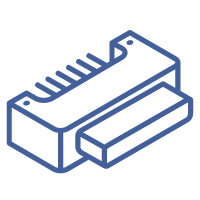
TE Connectivity CBS95-2P
CBS95-2P
16-SOIC (0.295, 7.50mm Width)
46159285-CBS95-2P
DIN Rail Terminal Blocks CBS95-2P
- Mounting TypeSurface Mount
- Package / Case16-SOIC (0.295, 7.50mm Width)
- Supplier Device Package16-SOIC
- Housing MaterialPolyamide (PA)
- PackageBulk
- MfrHarris Corporation
- Product StatusActive
- Voltage, Rating1 kV
- Factory Pack QuantityFactory Pack Quantity2
- Mounting StylesDIN Rail
- Wire Gauge Min8 AWG
- Part # Aliases1SNF526011R0000
- ManufacturerTE Connectivity
- BrandTE Connectivity / Entrelec
- Wire Gauge Range8 AWG to 0 AWG
- RoHSDetails
- Voltage Rated
RATED voltage is the voltage on the nameplate - the "design point" for maximum power throughput and safe thermal operation.
1000 V - Operating Temperature
The operating temperature is the range of ambient temperature within which a power supply, or any other electrical equipment, operate in. This ranges from a minimum operating temperature, to a peak or maximum operating temperature, outside which, the power supply may fail.
-40°C ~ 85°C - Series-
- Packaging
Semiconductor package is a carrier / shell used to contain and cover one or more semiconductor components or integrated circuits. The material of the shell can be metal, plastic, glass or ceramic.
Bulk - TypeCompact Terminal Block
- Number of Positions2 Position
- ColorGray
- Number of Rows1 Row
- SubcategoryTerminal Blocks
- Current Rating (Amps)200 A
- Current Rating
Current rating is the maximum current that a fuse will carry for an indefinite period without too much deterioration of the fuse element.
200 A - Output TypeVoltage - Buffered
- Number of Bits8
- Number of Poles1
- ArchitectureR-2R
- Reference Type
a code object that is not stored directly where it is created, but that acts as a kind of pointer to a value stored elsewhere.
External - Data Interface
A Data Interface in EDQ is a template of a set of attributes representing a given entity, used to create processes that read from, or write to, interfaces rather than directly from or to sources or targets of data.
Parallel - Differential Output
a differential output voltage in electronics is the difference between the values of two AC voltages, 180° out of phase, present at the output terminals of an amplifier when you apply a differential input voltage to the input terminals of an amplifier.
No - Product Type
a group of products which fulfill a similar need for a market segment or market as a whole.
DIN Rail Terminal Blocks - Voltage - Supply, Analog4.5V ~ 7.5V
- Voltage - Supply, Digital4.5V ~ 7.5V
- Settling Time
In control theory the settling time of a dynamical system such as an amplifier or other output device is the time elapsed from the application of an ideal instantaneous step input to the time at which the amplifier output has entered and remained within a specified error band.
20ns (Typ) - INL/DNL (LSB)±1 (Max), ±0.75LSB (Max)
- Connection Method
the systematic way of connecting the Power Plant (units) to the power grid.
Screw - Number of D/A Converters1
- Load Side Connection Type
Applied when there are no circuit breaker slots available. The wires are connected directly to the existing wires, between the electrical panel and (on the load side of) the main breaker. Some utilities do not allow this connection or do so only if it is approved by a professional electrician.
Screw Connection - Line Side Connection Type
This method requires that the wires from the inverter are connected to the service wires on the line side of the circuit breaker. This connection is very rarely allowed for residential systems but is increasingly common in commercial systems. Utilities usually require that the design for this connection and the installation are approved by a professional electrician.
Screw Connection - Load Side Connections Per Pole2
- Line Side Wire/Stud Size2/0-8 AWG
- Line Side Connections Per Pole2
- Load Side Wire/Stud Size2/0-8 AWG
- Product Category
a particular group of related products.
DIN Rail Terminal Blocks - Width25.5 mm
- Height57 mm
- Length93 mm
- Flammability RatingUL 94V-2








